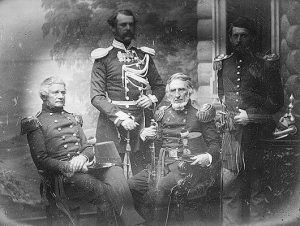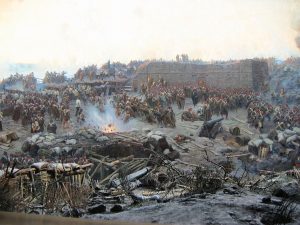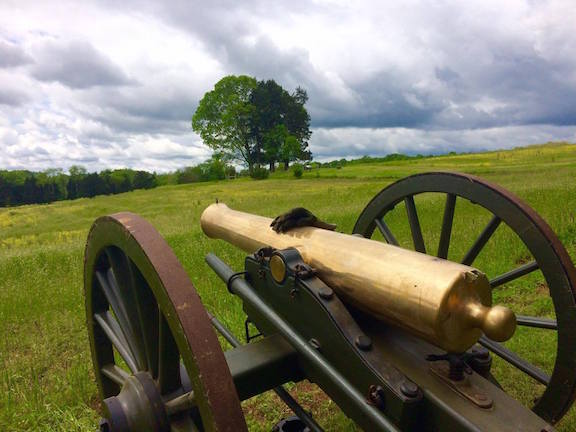Artillery: Alfred Mordecai, the Napoleon, and Changing Artillery
 Many know Arthur Fremantle, the famed British observer sent to the United States to observe the respective armies in the Civil War. Fremantle was just one of many observers from Great Britain, Prussia, France, and even Hungary sent by their governments to detail how Federal and Confederate soldiers killed each other. But what is perhaps less known that just five years before the Civil War started, the American government did the same thing—it sent a team of observers to the Crimean War to report back on the most recent developments from European warfare. Most importantly, the American government sent a trio of observers collectively known as the Delafield Commission, named for the officer in charge, Maj. Richard Delafield. Accompanying Delafield were Maj. Alfred Mordecai and Captain George McClellan.
Many know Arthur Fremantle, the famed British observer sent to the United States to observe the respective armies in the Civil War. Fremantle was just one of many observers from Great Britain, Prussia, France, and even Hungary sent by their governments to detail how Federal and Confederate soldiers killed each other. But what is perhaps less known that just five years before the Civil War started, the American government did the same thing—it sent a team of observers to the Crimean War to report back on the most recent developments from European warfare. Most importantly, the American government sent a trio of observers collectively known as the Delafield Commission, named for the officer in charge, Maj. Richard Delafield. Accompanying Delafield were Maj. Alfred Mordecai and Captain George McClellan.

All three men wrote reports on their findings, and soon those observations found their way onto American battlefields. And one of the most important objects to come from the Delafield Commission, specifically the report of ordnance officer Mordecai, was his observation of the French cannon-obusier—the gun-howitzer. To American audiences, the cannon that Mordecai witnessed in the Crimean and wanted so desperately in the United States came to be known as another name: the Napoleon.
For time immortal, as long as there had been artillery, those artillery pieces had generally been broken into three categories: guns, howitzers, and mortars. The latter, mortars, haven’t changed much since their inception—they were designed to fire rounds generally short distances in high arcs to get over walls or fortifications. Mortars were really only dragged out for longer sieges, when an attacking force was trying to bombard his enemy into submission. The former though, guns and howitzers, were the field pieces that armies took campaigning.
Guns, or, if one would prefer, cannons, fired their shots in a generally straight-trajectory. They could be used to hammer away at thick enemy formations, or, if placed correctly, could be used to fire directly into an enemy’s fortification. But, if an attacker wanted to get rounds over a wall, instead of into a wall, they would have to bring up a howitzer. Similar to cannons in that they could be transported on campaign by having the tube sit on a carriage with wheels and transported either by horse or oxen, the howitzer differed in that it had a shorter, squatter barrel that arced its shells higher than the straight shots of guns. The high ranging arc limited the range of howitzers, though. And, with different ordnances designed for different purposes, artillery batteries in the early 19th century, especially American batteries, were of mixed calibers and functions. Some of the pieces in a battery would be guns, others would be howitzers. This caused massive headaches for ordnance officers responsible for keeping batteries outfitted with the correct ammunition.
Those problems would be familiar to Alfred Mordecai, who graduated from West Point in 1823 as an engineer. After ten years’ of capable service, Mordecai got transfer orders as a captain in the ordnance department. From 1832 until his part as a commissioner to the Crimean War, Mordecai served as chief ordnance officer to places like the Frankford Arsenal in Pennsylvania, and the Washington Arsenal in the nation’s capital. He sat on ordnance boards inspecting artillery pieces and passing reforms that saw the American artillery dominate its Mexican opponents in the Mexican War of 1846-48. Thus, with the Delafield Commission’s need for an ordnance expert, Mordecai was the logical choice to head to the Crimean.
Most famously the Crimean War focused on the Siege of Sevastopol as British, French, and other Allied powers spent months attacking the Russian forces ensconced in the city. Though the Delafield Commission arrived after the city had fallen to the allies and thus they did not witness any combat, the commissioners saw the tools and weapons that both sides had used. And Mordecai, seeing the French “gun-howitzer” for the first time, became infatuated with it.

France, at the time, was led by Louis-Napoleon, better known as Napoleon III, nephew to the Corsican. Louis had spent his younger years as an artillery officer, and thus, now at the helm of the third French empire, sought to make his artillery the best in Europe. The new design for the “gun-howitzer” saw innovations that allowed for an elevating screw at the breech of the gun that could be turned, changing the trajectory of the shots and shells. The new gun-howitzer could also fire different types of ammunition; whereas before ordnance officers had to carefully keep separate and stocked ammunition for different guns or howitzers, now the French had a weapon that obliterated that system. Mordecai noted in his eventual report that the gun-howitzer had the capabilities of “firing the several kinds of projectiles for which different sorts of ordnance [emphasis mine] are generally employed in field service. . . solid shot, shells, spherical case-shot, and canisters…” He went on, “The great advantages that will attend this extreme simplification of field artillery must be obvious to every one who reflects on the inconveniences of the present complex system of pieces varying in kind and caliber.”[1] While Mordecai talked about other innovations in his report, his fixation on the cannon-obusier remained.

That fixation soon bore fruit. With Napoleon III’s agreement, a number of gun-howitzers were sent to the United States to be copied by American ordnance officers and tested. Out of those tests came the American copy of the French cannon-obusier: the Model 1857 12-pounder gun-howitzer. To American audiences, it became better known as the “Napoleon.” In the fall of 1857 the first four Napoleons entered service, sent to Ft. Leavenworth, Kansas. The first artillery officer to receive the guns was Capt. Henry Hunt, who in time would become the Army of the Potomac’s artillery chief. Just like Mordecai, Hunt became fascinated with the new pieces.

The Napoleon’s impression on other artillery officers soon took hold. Writing in 1860, Capt. John Gibbon (who would soon become a Federal general) authored his The Artillerist’s Manual. In that manual, Gibbon surmised that the new model Napoleon “will probably replace…both the guns and howitzers now in use.”[2]
Of course, Gibbon’s prediction came true. With the start of the Civil War, the bronze 12-pounder Napoleon soon became the work horse for both sides’ artillery. It was found on nearly every battlefield and became the terror of advancing infantry when gunners loaded canister rounds, turning the smoothbore gun into a giant shotgun.
As a conclusion, the dramatic ways that the Napoleon took the artillery by storm can be seen by glancing at ordnance reports from the Army of the Potomac. In July 1861, following the Union debacle at First Manassas, the Federal army in Washington, D.C. had only four Napoleons in its mix of weapons. Only a year and a half later, in October 1862, the Army of the Potomac had 321 pieces of artillery. Of those pieces, 126 of them, nearly 40%, were Napoleons.[3
______________________________________________________________
[1] Major Mordecai, Alfred, Military Commission to Europe (Washington D.C.: George Bowman Printer, 1861), 141.
[2] Gibbon, John, The Artillerist’s Manual (New York: D. Van Nostrad, 1860) 65.
[3] Nosworthy, Brent, Bloody Crucible of Courage (Constable Publishing, 2005), 464.
I think (forgive me for being picky) that the Napoleons were made of bronze, not brass. The two alloys (both copper-based) are often confused. Brass (copper and zinc) tends to be more decorative, bronze (copper and tin) less so.
Interesting. One point of possible confusion – the reference to adding an elevating screw. The US M1841 12 lb. Field Howitzer had an elevating screw and the 1861 Ordnance Manual gives ranges for it at the usual set of varying elevations – up to 5 degrees. That elevation was generally considered the maximum effective elevation for many guns – including the M1857 Napoleon, 3″ ordnance rifle, and 10 lb. Parrott. The real difference was the shorter barrel, use of a chamber for the weaker powder charge, and inability to fire solid shot. At the outset of the war it was not unusual for a 6-gun battery to be equipped with 4 guns and 2 howitzers. Henry Hunt hated the howitzers. Their limitations were exemplified by the decision Michael Wiedrich made at 2 BR when his 1st NY Light Battery I was summoned to Chinn Ridge to meet the Confederate attack on Day 2. He took only his 4 rifles, leaving his 2 howitzers behind because of their shorter range. Ultimately they were uniform;y phased out on the Union side.
For time immortal? Surely he meant since time immemorial.